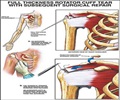
Fitness evaluation and pre-participation are standard practice in university sport. They screen the athletes for health problems and for high-risk behaviors which may affect performance throughout the season. Researchers from the Faculty of Physical Education and Recreation and the Faculty of Rehabilitation Medicine at the University of Alberta, measured pre-season fitness for six varsity teams.
They used a vertical jump test to estimate instantaneous anaerobic power and lower body strength and a sit and reach test to evaluate lower back and hip flexibility. Another test measured agility (acceleration, deceleration, pivoting and quick footwork). Push-ups were used to measure upper body endurance, and sit-ups determined core strength and flexibility. Shoulder flexibility was also assessed. Both practice and game time were recorded to give to time to injury.
Over two thirds of the sports players in the study suffered injury throughout the season, most commonly muscle or tendon strain in the legs or feet. Although players missed practice time due to their injuries (55% missed at least one practice due to injury) most did not miss any games. In fact about 40% of injuries occurred during preseason practice.
Time to first injury was shorter for the women than the men occurring on average 40% of the way through the season for female athletes, and 66% of the way through the season for males. Time to injury also depended on sport with the injuries occurring sooner in volleyball than any other sport tested. For women, volleyball injury occurred, on average, less than 20% of the way through the season, and 35% for men. Men's hockey was the safest sport with first injuries only occurring, on average, three quarters of the way through the season.
Analysis of the fitness evaluation showed that time to injury was not affected by the level of pre-season fitness. Michael Kennedy, one of the team who performed this study explained, "The only association we found between preseason fitness and injury was that lower upper body strength, as evaluated by push-ups, was associated with a shorter time to injury - this was despite most of the injuries being associated with the lower body."
Advertisement
This article is part of the Advances in Sports Nutrition, Exercise and Medicine cross-journal thematic series, which includes articles offering novel insights and clinical significance in all aspects of sports medicine.
Advertisement
Source-Eurekalert








